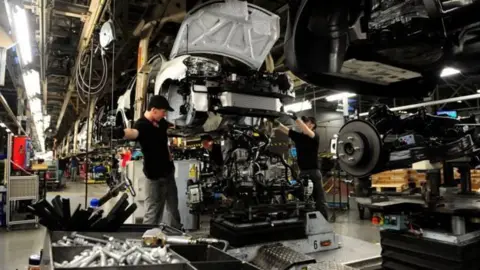Reality Check: How big is the pay gap?
 PA
PAThe UK's biggest companies will have to reveal how much more their chief executives are paid compared with the average worker.
The measure, which is part of a package of government policy initiatives, will oblige some 900 companies owned by shareholders to reveal the pay ratio between bosses and workers.
But just how big is the gap at the top and is it worse across different sectors?
Reality Check has been looking at the numbers.

What's happening to pay at the top?
We already have some insight into executive pay, based on joint research by the High Pay Centre and the Chartered Institute of Personnel and Development (CIPD).
The report examined the top 100 UK companies listed on the stock market and found chief executive salaries had dropped 17.4% in 12 months.
The average FTSE 100 boss had received £4.5m in 2016, down from £5.4m in 2015.
But while there was an overall fall in top pay, the gulf between top executives and average workers still persists.
The average employee of a FTSE 100 company makes £48,000 a year (in contrast to the UK full-time average of £28,000).
This means that for every £1 the average worker earns, their chief executive makes £129.
The High Pay Centre says that while this has come down from 2015, when the ratio was £148-£1, it is still high when compared with the £45-£1 ratio 20 years ago.
Pay ratios differ across sectors.
Technology companies in the FTSE 100 have the lowest ratio, at £27-£1.
At the other end, consumer services has the highest ratio, at £248-£1. However, executive pay in this sector is inflated by two companies - WPP and Carnival - who pay their chief executives the top packages.
The financial sector, which has come under a lot of scrutiny over banker bonuses in recent years, emerges pretty well, with a gap of £68-£1 - although that does reflect the relatively high pay of its average employee.

Who earns the most?
Source: High Pay Centre / CIPD

Could publishing pay ratios have unintended consequences?
For the likes of Stefan Stern, head of the High Pay Centre, the publication of pay ratios will provide greater transparency and "concentrate minds on how the gap has grown".
Critics concede the policy will improve transparency, but they warn that pay ratios do not always tell the full story.
The director general of the Institute of Directors, Stephen Martin, says: "Pay ratios will sharpen the awareness of boards on the issue of remuneration, but they can be a crude measure."
One issue is that rather than reducing pay at the top (or increasing it at the bottom), a boss may look at other ways to reduce the ratio - for example, through outsourcing some jobs, increasing automation or hiring more part-time workers at the expense of full-time employees.



